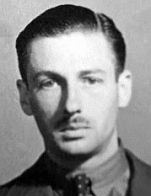Rank Squadron leader Commands held Stationer circuit Battles and wars World War II | Unit Section F Died March 17, 1990 Years of service 1939-1945 Name Maurice Southgate | |
 | ||
Born 20 June 1913 ( 1913-06-20 ) Service/branch | ||
maurice southgate
Maurice Southgate (20 June 1913—17 March 1990) was a British RAF officer who served in the Special Operations Executive (SOE) during World War II. Under the codename "Hector", he organised the STATIONER circuit operating across the Limousin region from 1942 to 1944. He was captured by the Gestapo near Montluçon in 1944 and deported to Buchenwald concentration camp where he remained until its liberation by American forces in 1945.
Contents
Biography
Little is known of Maurice Southgate's early life, but it is understood he was educated in Paris, attending a technical college, which later allowed him to start his own upholstery business.
With the coming of World War II, Southgate was part of the British Expeditionary Force, and in June 1940 was evacuated from Saint-Nazaire on the RMS Lancastria, which was later sunk by German aircraft. Fortunately, Southgate was able to swim away, being picked up by another vessel which later docked in Falmouth, Cornwall. In England he was posted by the RAF to the Air Ministry, where notably, he became reacquainted with his childhood friend Pearl Witherington. In May 1942 his name was passed through to SOE's French Section, where he was accepted for training in July. His superiors were impressed with his serious and thorough approach, resulting in him being readied for the job of organiser for the newly established STATIONER circuit. In January 1943, after parachuting near Clermont-Ferrand with his wireless operator Jacqueline Nearne, Southgate began establishing communication networks around Vierzon, Châteauroux and Limoges, and also in the far south-west, around Tarbes.
Towards the end of the summer STATIONER began to attack railway targets, power stations and aircraft works, in the hope that more adventurous sabotage was possible. In September a courier, Pearl Witherington, arrived to assist, and a month later Southgate was flown back to London to report on his progress.
Returning to France, just before D-Day to help with the incoming Allied invasion, Southgate landed near Toulouse in January 1944. Burdened with a considerable workload, including the command of 2,500 men, on 1 May 1944, a weary Southgate was caught by a Gestapo trap in Montlucon, where he missed the secret signal. After interrogation, Southgate was deported to Germany, to the Buchenwald concentration camp, where 16 of his compatriots were hanged. He escaped this fate through feigning illness and was admitted to the camp hospital. Southgate spent several more weeks being genuinely ill. After which he was moved to work in the tailor's shop, where he kept a low profile and remained until American forces liberated Buchenwald on 11 April 1945.
Extracts from Southgate's wartime diary have been published online.
